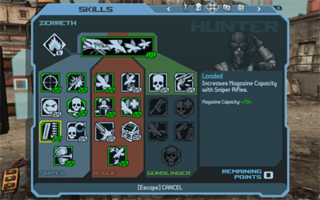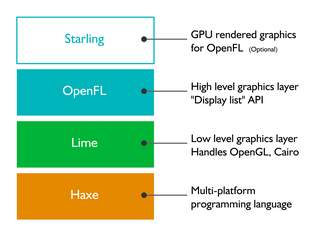Related Research Articles
Adobe Flash is a discontinued multimedia software platform used for production of animations, rich internet applications, desktop applications, mobile apps, mobile games, and embedded web browser video players.
SWF is a defunct Adobe Flash file format that was used for multimedia, vector graphics and ActionScript.

Adobe Shockwave is a discontinued multimedia platform for building interactive multimedia applications and video games. Developers originate content using Adobe Director and publish it on the Internet. Such content could be viewed in a web browser on any computer with the Shockwave Player plug-in installed. MacroMind originated the technology; Macromedia acquired MacroMind and developed it further, releasing Shockwave Player in 1995. Adobe then acquired Shockwave with Macromedia in 2005. Shockwave supports raster graphics, basic vector graphics, 3D graphics, audio, and an embedded scripting language called Lingo.
A Rich Internet Application is a web application that has many of the characteristics of desktop application software. The concept is closely related to a single-page application, and may allow the user interactive features such as drag and drop, background menu, WYSIWYG editing, etc. The concept was first introduced in 2002 by Macromedia to describe Macromedia Flash MX product. Throughout the 2000-s, the term was generalized to describe browser-based applications developed with other competing browser plugin technologies including Java applets, Microsoft Silverlight.
Reality Lab was a 3D computer graphics API created by RenderMorphics to provide a standardized interface for writing games. It was one of the main contenders in the realtime 3D middleware marketplace at the time, alongside Criterion Software's RenderWare and Argonaut Software's BRender.
A shading language is a graphics programming language adapted to programming shader effects. Shading languages usually consist of special data types like "vector", "matrix", "color" and "normal".
Adobe Flash Player is computer software for viewing multimedia content, executing rich Internet applications, and streaming audio and video content created on the Adobe Flash platform. It can run from a web browser as a browser plug-in or independently on supported devices. Originally created by FutureWave under the name FutureSplash Player, it was renamed to Macromedia Flash Player after Macromedia acquired FutureWave in 1996. It was then developed and distributed by Adobe as Flash Player after Adobe acquired Macromedia in 2005. It is currently developed and distributed by Zhongcheng for users in China, and by Harman International for enterprise users outside of China, in collaboration with Adobe.

Adobe AIR is a cross-platform runtime system currently developed by Harman International, in collaboration with Adobe Inc., for building desktop applications and mobile applications, programmed using Adobe Animate, ActionScript, and optionally Apache Flex. It was originally released in 2008. The runtime supports installable applications on Windows, macOS, and mobile operating systems, including Android, iOS, and BlackBerry Tablet OS.
Web3D, also called 3D Web, is a group of technologies to display and navigate websites using 3D computer graphics.

WebGL is a JavaScript API for rendering interactive 2D and 3D graphics within any compatible web browser without the use of plug-ins. WebGL is fully integrated with other web standards, allowing GPU-accelerated usage of physics, image processing, and effects in the HTML canvas. WebGL elements can be mixed with other HTML elements and composited with other parts of the page or page background.

Away3D is an open-source platform for developing interactive 3D graphics for video games and applications, in Adobe Flash or HTML5. The platform consists of a 3D world editor, a 3D graphics engine, a 3D physics engine and a compressed 3D model file format (AWD).
Epic Citadel is a tech demo developed by Epic Games to demonstrate the Unreal Engine 3 running on Apple iOS, within Adobe Flash Player Stage3D and using HTML5 WebGL technologies. It was also released for Android on January 29, 2013.

Starling is an open source game framework used to create 2D games that run both on mobile and desktop platforms. It recreates the traditional Flash display list architecture on top of accelerated graphics hardware. Several commercial games have been built with Starling, including Angry Birds Friends and Incredipede.

Flare3D is a framework for developing interactive three-dimensional (3D) graphics within Adobe Flash Player, Adobe Substance and Adobe AIR, written in ActionScript 3. Flare3D includes a 3D object editor and a 3D graphics engine for rendering 3D graphics. Flare3D runs on current web browsers utilizing the Adobe Flash Player, and uses Stage3D for GPU-accelerated rendering. Flare3D has not been under active development since late 2014.
CrossBridge is an open-source toolset developed by Adobe Systems, that cross-compiles C and C++ code to run in Adobe Flash Player or Adobe AIR. Projects compiled with CrossBridge run up to 10 times faster than ActionScript 3 projects. CrossBridge was also known as "Alchemy" and the "Flash Runtime C++ Compiler", or "FlasCC".
Stage3D is an Adobe Flash Player API for rendering interactive 3D graphics with GPU-acceleration, within Flash games and applications. Flash Player or AIR applications written in ActionScript 3 may use Stage3D to render 3D graphics, and such applications run natively on Windows, Mac OS X, Linux, Apple iOS and Google Android. Stage3D is similar in purpose and design to WebGL.

Scaleform GFx is a discontinued game development middleware package, a vector graphics rendering engine used to display Adobe Flash-based user interfaces and HUDs for video games. In March 2011, Autodesk acquired Scaleform Corporation and Scaleform GFx became part of the Autodesk Gameware line of middleware. On July 12, 2018, Autodesk discontinued Scaleform GFx, and it is no longer available for purchase.
Adobe Scout is a visual profiler for Adobe Flash content running on desktop or mobile platforms, and works together with Adobe Flash Player and Adobe AIR. Scout enables in-depth profiling of ActionScript 3 code execution, 2D graphics and text rendering, and 3D graphics rendered via the Stage3D application programming interface (API).

OpenFL is a free and open-source software framework and platform for the creation of multi-platform applications and video games. OpenFL applications can be written in Haxe, JavaScript, or TypeScript, and may be published as standalone applications for several targets including iOS, Android, HTML5, Windows, macOS, Linux, WebAssembly, Flash, AIR, PlayStation 4, PlayStation 3, PlayStation Vita, Xbox One, Wii U, TiVo, Raspberry Pi, and Node.js.
References
- ↑ Doug McCune; Deepa Subramaniam (2009). Adobe Flex 3.0 For Dummies. John Wiley & Sons. pp. 388–389. ISBN 978-0-470-40789-9.
- ↑ Cheridan Kerr; Jonathan Keats (2009). The Essential Guide to Flash CS4. Apress. p. 286. ISBN 978-1-4302-2353-5.
- ↑ Matthew David (2012). Flash Mobile: Developing Android and IOS Applications. CRC Press. p. 199. ISBN 978-1-136-02250-0.
- 1 2 Remi Arnaud (2011). "3D in a Web Browser". In Eric Lengyel (ed.). Game Engine Gems 2. CRC Press. pp. 207–212. ISBN 978-1-56881-437-7.
- ↑ Adobe Gaming SDK, Adobe